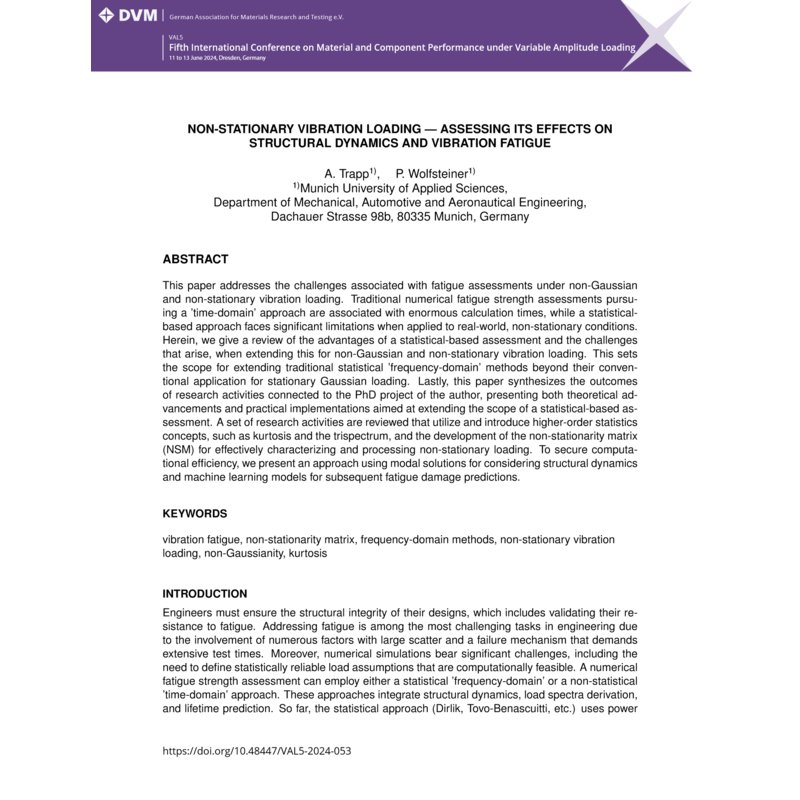- Nur online erhältlich



Engineers must ensure the structural integrity of their designs, which includes validating their resistance to fatigue. Addressing fatigue is among the most challenging tasks in engineering due to the involvement of numerous factors with large scatter and a failure mechanism that demands extensive test times.
Moreover, numerical simulations bear significant challenges, including the need to define statistically reliable load assumptions that are computationally feasible. A numerical fatigue strength assessment can employ either a statistical 'frequency-domain' or a non-statistical 'time-domain' approach. These approaches integrate structural dynamics, load spectra derivation, and lifetime prediction. So far, the statistical approach (Dirlik, Tovo-Benascuitti, etc.) uses power…

Datenschutzbedingungen (bearbeiten im Modul "Kundenvorteile")

Lieferbedingungen (bearbeiten im Modul "Kundenvorteile")

Rücksendebedingungen (bearbeiten im Modul "Kundenvorteile")
Engineers must ensure the structural integrity of their designs, which includes validating their resistance to fatigue. Addressing fatigue is among the most challenging tasks in engineering due to the involvement of numerous factors with large scatter and a failure mechanism that demands extensive test times.
Moreover, numerical simulations bear significant challenges, including the need to define statistically reliable load assumptions that are computationally feasible. A numerical fatigue strength assessment can employ either a statistical 'frequency-domain' or a non-statistical 'time-domain' approach. These approaches integrate structural dynamics, load spectra derivation, and lifetime prediction. So far, the statistical approach (Dirlik, Tovo-Benascuitti, etc.) uses power spectral densities to characterize loading and stresses, while the non-statistical approach involves the computationally costly processing of time-domain realizations via counting algorithms such as rainflow counting. However, non-stationary vibration loading, commonly encountered in real applications, leads to significant deviations between both approaches. As such non-stationary vibration loading remains a central ongoing research topic in vibration fatigue.
This contribution delves into the challenges associated with non-stationary-, or more broadly spoken, non-Gaussian loading. Decisive for fatigue is how these characteristics affect the dynamic behavior of structures. This analysis is provided by structural dynamics, assessing whether the dynamic potential of vibration loading correlates with the critical structural modes, which is the prerequisite for large numbers of high amplitudes potentially inflicting severe fatigue damage to critical structural cross-sections. We show how this analysis can be extended to non-Gaussian and non-stationary loading, which is mainly based on the theory of higher-order spectral analysis. Respectively in terms of its results – we discuss how kurtosis transfers through linear systems. With this extension of linear systems theory to higher-order characterizations, we present the theoretical justification to well-known experimental results that show, that non-stationarity is the critical mechanism for fatigue and foremost accountable for the deviations between a statistical ‘frequency-domain’ and the classic time-domain approach. We further draw the parallel to the popular Fatigue Damage Spectrum.
After establishing non-stationarity as the critical characteristic, we discuss the most promising approaches for dealing with non-stationary loading while making use of the computational efficiency of a statistical ‘frequency-domain’ fatigue assessment. We discuss and compare the approaches of a) quasi-stationary load assumptions, b) processing a spectral representation of kurtosis via linear systems theory – the non-stationarity matrix – and evaluating its responses using a machine learning damage estimator, and c) making use of the modal approach of the Fatigue Damage Spectrum. This benchmark is based on a real-world example from railway industry and supported by an open-source Python package, pyRaTS, written by the authors.